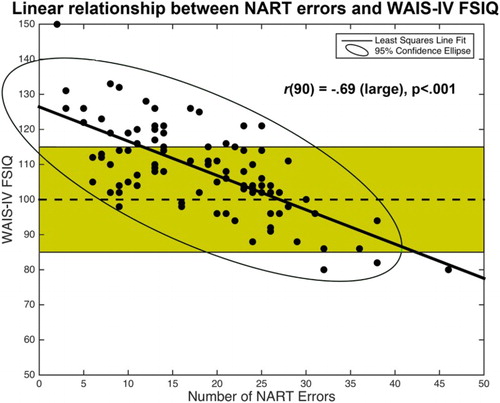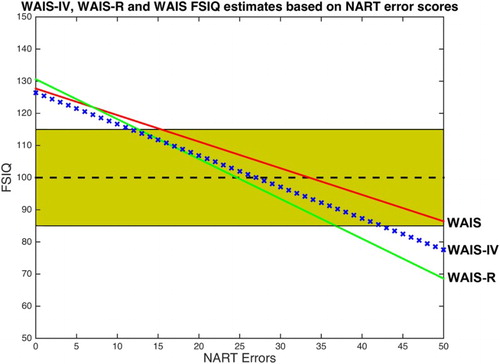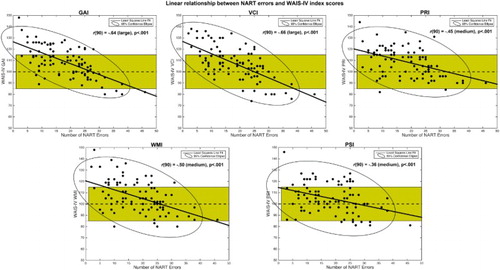ABSTRACT
Since publication in 1982, the 50-item National Adult Reading Test (NART; Nelson, 1982; NART–R; Nelson & Willison, 1991) has remained a widely adopted method for estimating premorbid intelligence both for clinical and research purposes. However, the NART has not been standardised against the most recent revisions of the Wechsler Adult Intelligence Scale (WAIS-III; Wechsler, 1997, and WAIS-IV; Wechsler, 2008). Our objective, therefore, was to produce reliable standardised estimates of WAIS-IV IQ from the NART. Ninety-two neurologically healthy British adults were assessed and regression equations calculated to produce population estimates of WAIS-IV full-scale IQ (FSIQ) and constituent index scores. Results showed strong NART/WAIS-IV FSIQ correlations with more moderate correlations observed between NART error and constituent index scores. FSIQ estimates were closely similar to the published WAIS and WAIS-R estimates at the high end of the distribution, but at the lower end were approximately equidistant from the highly discrepant WAIS (low) and WAIS-R (high) values. We conclude that the NART is likely to remain an important tool for estimating the impact of neurological damage on general cognitive ability. We advise caution in the use of older published WAIS and/or WAIS-R estimates for estimating premorbid WAIS-IV FSIQ, particularly for those with low NART scores.
Introduction
First published in 1982, the 50-item National Adult Reading Test (NART; Nelson, Citation1982; NART–R; Nelson & Willison, Citation1991) remains a widely used method for estimating premorbid intelligence in both clinical and research settings. However, the NART has not been standardised against the most recent revisions of the Wechsler Adult Intelligence Scale test battery, WAIS-III (Wechsler, Citation1997) and WAIS-IV (Wechsler, Citation2008). This presents a major drawback, since unless the now obsolete WAIS-R battery is also employed (against which NART-R is standardised), predicted premorbid IQ is likely to be inaccurate.
In this paper we present NART-derived estimates of WAIS-IV full scale IQ (FSIQ). Participants were tested on all 10 core subtests of the WAIS-IV battery (along with the five supplementary tests) and the NART, according to published instructions. In addition, the Wechsler Test of Adult Reading (WTAR; Wechsler, Citation2001) was administered, providing an estimate of premorbid IQ against WAIS-III (but not WAIS-IV). The WTAR was subsequently revised and renamed as the Test of Premorbid Functioning (TOPF), available as a subtest of the Advanced Clinical Solutions kit in the United States (Pearson, Citation2009), and as a stand-alone test in the UK (Wechsler, Citation2011), but it has been less widely adopted.
The main alternative to the employment of reading ability tests for estimating premorbid ability is to use demographic variables (which have the potentially important advantage of being entirely independent of current cognitive status). Equations based solely on demographic data or a combination of demographics and NART performance have been presented (e.g., Crawford et al., Citation1989; Crawford, Nelson, Blackmore, Cochrane, & Allan, Citation1990), with some disagreement on whether or not the latter adds predictive value (e.g., O'Carroll, Citation1995).
Bright, Jaldow, and Kopelman (Citation2002) tested the validity of NART, NART-R and demographic variables for predicting WAIS and WAIS-R-derived IQs in 98 neurologically impaired patients (frontal lesion, Korsakoff syndrome and Alzheimer’s disease) and 51 healthy controls. Results indicated significantly stronger correlations between NART/NART-R and WAIS/WAIS-R IQ than between demographic-derived estimates and WAIS/WAIS-R IQ (with no significant additional benefit for estimates derived from combined NART and demographic variables). Furthermore, in the controls, NART (in both original and revised formats) produced an estimated WAIS/WAIS-R FSIQ that was within one IQ point of actual WAIS/WAIS-R FSIQ. The reassurance that these findings provide for the continued use of the NART in clinical, research and medico-legal settings is offset by the absence of up-to-date estimates against more recent revisions of the WAIS. If the NART is to be used in the assessment of cognitive ability in neurological conditions, the ability to estimate premorbid intelligence in terms of a WAIS-IV IQ will facilitate more reliable and valid comparison with current intelligence (which will normally have been measured using WAIS-IV). The aim of this research, therefore, was to provide reliable estimates of WAIS-IV performance from NART scores.
Method
An opportunity sample of 100 neurologically healthy participants was recruited. Of these, eight did not complete all tests and were excluded from subsequent analyses. All of the 92 participants were British nationals (mean age 40 years; range 18–70; SD 16.78), with English as the first language, and with normal/corrected-to-normal vision and hearing. Informed written consent was obtained from all participants following an explanation of the experiment. Procedures were approved by the University ethics panel, and followed the tenets of the Declaration of Helsinki. Data were collected from all participants in one session.
Demographic information (age, gender, years of education, occupation) was recorded prior to the completion of the psychometric tests. The NART, WTAR and WAIS-IV were then administered (in that order) according to standardised instructions. Extensive training in the administration and scoring of all tests was provided by an experienced and qualified neuropsychologist (the lead author). The WAIS-IV supplementary tests were administered to all participants at the end of the session, but will not be reported here. Social class was subsequently determined by occupational status using the Office of Population, Censuses and Surveys (Citation1980) classification (range 1–5) to ensure that the sample was broadly representative of the wider UK population in this regard. Participant demographics and descriptive statistics are provided in .
Table 1. Demographics and descriptive statistics.
Results and discussion
The present findings indicate that NART scores remain a reliable estimate of premorbid ability (). The correlation between NART and WAIS-IV scores was highly significant (r = .69, 95% CI = .56 to .78), although lower than published NART-WAIS and NART-WAIS-R correlations (typically ranging from .72 to .81; see Lezak, Citation2004). Linear regression equations were derived to produce reliable WAIS-IV IQ estimates on the basis of NART performance as follows (with published WAIS and WAIS-R estimates included for comparison purposes):
Predicted WAIS-IV FSIQ = −0.9775 × NART error score + 126.41
Predicted WAIS-R FSIQ = −1.24 × NART error score + 130.6 (Nelson & Willison, Citation1991)
Predicted WAIS FSIQ = −0.826 × NART error score + 127.7 (Nelson, Citation1982)
Figure 1. Scatterplot showing a large (Cohen, Citation1988) significant linear correlation between number of NART Errors and WAIS-IV FSIQ, with least squares line fit (black line), 95% confidence ellipse and ± 1 standard deviation around the normalised average IQ of 100 (shaded zone).

The standard error of estimate for predicted WAIS-IV FSIQ in our data was 9.25 (which compares with 8.6 and 7.6 for the published WAIS-R and WAIS FSIQs, respectively; Nelson & Willison, Citation1991). Caution should therefore be applied, particularly in cases where the disparity between estimated and observed FSIQ is of borderline clinical significance.
Mean NART estimates of WAIS-R and actual WAIS-IV mean FSIQ were remarkably similar (108.01 and 108.52, respectively). Point-by-point comparison against predicted WAIS and WAIS-R IQs included in the NART-R test manual shows similar estimates at the high end of the distribution (but lowest for WAIS-IV), with estimates at the lower end falling between the WAIS (higher) and WAIS-R (lower) FSIQ estimates (). NART error scores of 14–17 produced the same WAIS-IV and WAIS-R FSIQ, but there was no overlap in WAIS-IV and WAIS estimates. Lack of sensitivity for differentiating IQ levels above the normal range is a known issue (e.g., Nelson, Citation1982; Nelson & Willison, Citation1991), and it seems likely that premorbid abilities are underestimated in those scoring very highly on the NART (in our data, zero NART errors equates to a WAIS-IV FSIQ of 126, in comparison to WAIS and WAIS-R FSIQ estimates of 128 and 131, respectively). The lowest possible score of 50 NART errors in our sample provides a WAIS-IV FSIQ estimate of 78 (which compares to 86 and 69 for WAIS and WAIS-R FSIQ). Given the size of the disparity between NART-R and NART predicted IQs (e.g., 12 IQ points for an error score of 35; 16 points for an error score of 45), our data may offer an intuitively appealing “correction” to this large discrepancy in predicted scores towards the low end of the distribution. However, the precision of estimates at either end of the distributions should always be judged with particular caution, given the relatively low proportion of participants with very low or very high scores.
Figure 2. Regression line comparisons for NART-derived WAIS-IV FSIQ (current data), WAIS-R FSIQ and WAIS FSIQ (Nelson & Willison, Citation1991) estimates. Shaded zone indicates ± 1 standard deviation around the normalised average IQ of 100.

Index scores
In place of verbal IQ and performance IQ scales, four separate indices were introduced with WAIS-IV: Verbal Comprehension (VCI), Perceptual Reasoning (PRI), Working Memory (WMI) and Perceptual Speed (PSI). Additionally, scores on the Verbal Comprehension and Perceptual Reasoning subtests contribute to a General Ability Index (GAI), typically employed in cases in which disproportionate working memory and/or processing speed difficulties complicate the interpretation of FSIQ. presents scatter plots of NART error against each of these scales. The strongest correlations were observed for the GAI (r = .64) and VCI (r = .66), with more moderate correlations against WMI (r = .50) and PRI (r = .45). The correlation with PSI was particularly poor (r = .36; variance shared = 13%), and performance on the NART cannot, therefore, be converted to provide an appropriate estimate of basic/simple information processing ability. Linear regression equations derived to produce index estimates on the basis of NART performance were as follows:
Predicted GAI = −0.9656 × NART error score + 126.5
Predicted VCI = −1.0745 × NART error score + 126.81
Predicted PRI = −0.6242 × NART error score + 120.18
Predicted WMI = −0.7901 × NART error score + 120.53
Predicted PSI = −0.5285 × NART error score + 114.53
Figure 3. Scatterplots showing medium and large (Cohen, Citation1988) significant linear correlations between number of NART Errors and the GAI, and WAIS-IV subtests (VCI, PRI, WMI and PSI), with least squares line fit (black lines), 95% confidence ellipse and ± 1 standard deviation around the normalised average IQ of 100 (shaded zone).

Comparison of NART and WTAR
NART and WTAR performance was very highly correlated (r = .88, p < .001). WTAR scores provided similar correlations with FSIQ (r = .67) and component indices. The greatest disparity in strength of correlations was observed against PRI (r = .45 and r = .39 for NART and WTAR, respectively), but given the variance that remains unaccounted for (80% and 85%), neither test should be considered a precise method for identifying premorbid levels of perceptually-based fluid reasoning. Combining NART and WTAR data had a negligible effect on predictive accuracy of FSIQ estimates on the basis of NART alone (r = .70). provides the complete set of correlations for both tests (as well as for summed NART and WTAR scores).
Table 2. Pearson correlations of NART and WTAR scores against WAIS-IV FSIQ and index scores.
Conclusions
In summary, the present findings indicate that continued use of the NART as an important clinical tool for estimating premorbid levels of intellectual ability is justified, despite the availability of more recently developed measures. In our data, the sensitivity of NART to WAIS-IV scores differed markedly across the individual index scores. Given that both the NART and WTAR are tests of atypical phonemic pronunciation, it is perhaps unsurprising that the correlations with the verbal comprehension index were particularly strong, and it follows that the NART holds less value as a premorbid predictor for executive function and fluid ability. Sensitivity to the perceptual speed index was poor, and our data clearly indicate that assessment of impairment in this domain cannot be reliably estimated on the basis of NART (or WTAR) scores. Nevertheless, for completeness, we include NART-based estimates of all WAIS-IV indices in . It is important to recognise that our study employed the British version of the test, conducted on a British sample, and our findings do not therefore apply to other NART-based variants designed for different populations, such as the North American Adult Reading Test (Blair & Spreen, Citation1989; Spreen & Strauss, Citation1998) or the American National Reading Test (Gladsjo, Heaton, Palmer, Taylor, & Jeste, Citation1999).
Table 3. WAIS-IV Full Scale IQ plus index scores predicted from the number of errors made on the NART.
We suspect, given the limited range of predicted FSIQ scores (78–126), that the NART overestimates premorbid ability in those with very low scores and underestimates ability in those with very high scores (a point acknowledged by others, e.g., Nelson & Willison, Citation1991; Mathias, Bowden, & Barrett-Woodbridge, Citation2007; Spreen & Strauss, Citation1998). Given the difficulties in identifying participants at the extremes of the distribution, it is clear that the most reliable estimates will be in/around the average range (in our sample, for example, only eight participants produced 30 or more NART errors). Nevertheless, these justified concerns should be considered against the current absence of consistent evidence that any alternative approaches are superior to the NART (or similar tests based on reading ability of irregular words).
Disclosure statement
No potential conflict of interest was reported by the authors.
References
- Blair, J. R., & Spreen, O. (1989). Predicting premorbid IQ: A revision of the national adult reading test. Clinical Neuropsychologist, 3(2), 129–136. doi: 10.1080/13854048908403285
- Bright, P., Jaldow, E. L. I., & Kopelman, M. D. (2002). The national adult reading test as a measure of premorbid intelligence: A comparison with estimates derived from demographic variables. Journal of the International Neuropsychological Society, 8(06), 847–854. doi: 10.1017/S1355617702860131
- Cohen, J. (1988). Statistical power analysis for the behavioral sciences (2nd ed.). Hillsdale, NJ: Lawrence Erlbaum Associates.
- Crawford, J. R., Nelson, H. E., Blackmore, L., Cochrane, R. H. B., & Allan, K. M. (1990). Estimating premorbid intelligence by combining the NART and demographic variables: An examination of the NART standardisation sample and supplementary equations. Personality and Individual Differences, 11, 1153–1157. doi: 10.1016/0191-8869(90)90028-P
- Crawford, J. R., Stewart, L. E., Cochrane, R. H. B., Foulds, J. A., Besson, J. A. O., & Parker, D. M. (1989). Estimating premorbid IQ from demographic variables: Regression equations derived from a UK sample. British Journal of Clinical Psychology, 28, 275–278. doi: 10.1111/j.2044-8260.1989.tb01377.x
- Gladsjo, J. A., Heaton, R. K., Palmer, B. W., Taylor, M. J., & Jeste, D. V. (1999). Use of oral reading to estimate premorbid intellectual and neuropsychological functioning. Journal of the International Neuropsychological Society, 5(03), 247–254. doi: 10.1017/S1355617799533079
- Lezak, M. D. (2004). Neuropsychological assessment. New York: Oxford University Press.
- Mathias, J. L., Bowden, S. C., & Barrett-Woodbridge, M. (2007). Accuracy of the Wechsler Test of Adult Reading (WTAR) and National Adult Reading Test (NART) when estimating IQ in a healthy Australian sample. Australian Psychologist, 42(1), 49–56. doi: 10.1080/00050060600827599
- Nelson, H. E. (1982). National Adult Reading Test (NART): For the assessment of premorbid intelligence in patients with dementia: Test manual. Windsor: NFER-Nelson.
- Nelson, H. E., & Willison, J. (1991). National Adult Reading Test (NART). Windsor: NFER-Nelson.
- O'Carroll, R. (1995). The assessment of premorbid ability: A critical review. Neurocase, 1(1), 83–89. doi: 10.1080/13554799508402350
- Office of Population, Censuses and Surveys. (1980). Classification of occupations. London: HMSO.
- Pearson, N. C. S. (2009). Advanced clinical solutions for WAIS-IV and WMS-IV: Administration and scoring manual. San Antonio: The Psychological Corporation.
- Spreen, O., & Strauss, E. (1998). A compendium of neuropsychological tests. New York, NY: Oxford University Press.
- Wechsler, D. (1997). WAIS-III administration and scoring manual (3rd ed.). San Antonio, TX: The Psychological Corporation.
- Wechsler, D. (2001). Wechsler Test of Adult Reading: WTAR. San Antonio, TX: Psychological Corporation.
- Wechsler, D. (2008). Wechsler Adult Intelligence Scale (4th ed.). San Antonio, TX: Pearson Assessment.
- Wechsler, D. (2011). Test of Premorbid Functioning. UK version (TOPF UK). London: Pearson Assessment.
